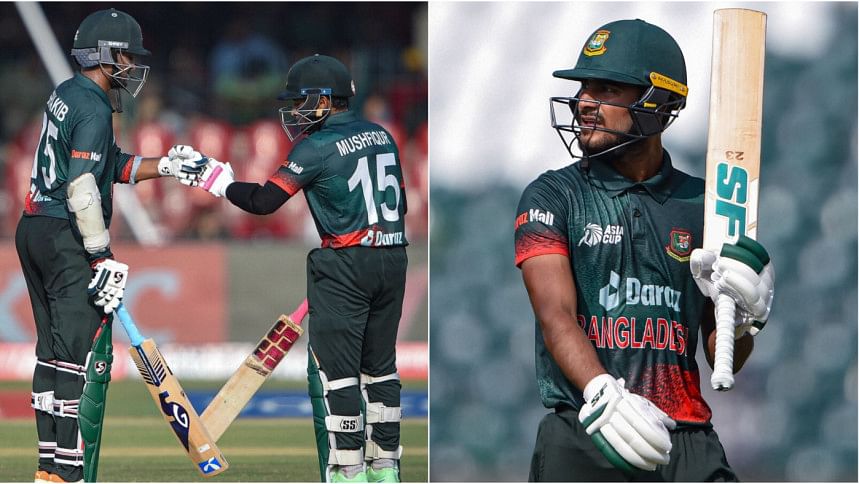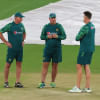Flawed game-reading proves disastrous yet again

When it works, it works like a charm. Otherwise, it appears to be a poorly put together batting plan. At the heart of it, however, is the failure to bat according to the match scenario which unfolded yet again for Bangladesh in their Asia Cup's Super Four fixture against Pakistan at Lahore's Gaddafi Stadium yesterday.
Bangladesh only managed to play 38.4 overs on a flat batting surface. The ball came into the bat very well and a lightning-fast outfield meant the ball was travelling fast. Bangladesh's task looked challenging at first, given the form that Shaheen Shah Afridi, Naseem Shah and Haris Rauf are carrying.
In essence, the idea then should have been pretty simple for Bangladesh: contain the pace attack by not giving away wickets, as the ball would move around, zip off the seam and come at pace in the first 10 overs.
The Tigers started badly when Naseem struck with his very first delivery, removing makeshift opener Mehedi Hasan Miraz, who had struck an important ton in the first game.
Liton Das, who joined the side after his fever came down, looked naturally elegant, cracking a few boundaries through the off side. Then Shaheen produced a delivery that took off from nowhere. Liton was drawn slightly forward; the ball leaving him at an angle before Liton waddled his bat around to nick it through to the wicket-keeper.
While Miraz and Liton could be excused for the nature of their dismissals, most of the latter batters would have little to say about the quality of deliveries.
With two wickets gone, Mohammad Naim's task was to see off the early Shaheen and Naseem spell along with Shakib Al Hasan. He was in no position when he tried to pull Rauf and gave away his wicket cheaply, unable to fulfil the task that should have been set from the team management.
Tawhid Hridoy might have been rattled by Rauf's raw pace but Shakib alongside Mushfiqur Rahim put together a 100-run stand. When things were going well, Shakib miscued one from Faheem Ashraf after a 57-ball 53. On Shakib's part, the ball was indeed there to be hit.
Mushfiqur would soon notch his fifty with Shamim Hossain looking set at the other end.
The match scenario was set with the score at 174 with five wickets remaining after 34 overs. The two batters at the crease along with Afif Hossain to come, had to ensure at least 250 first before making a reach for something bigger. The fragility of the lower-order was shown but more acute was the failure to judge risk and rewards according to the run of play. Instead of ensuring 250 first, they went after quality bowlers without heeding the scenario.
Shamim skied one, showing he had not understood what was required as he fell for 16 to part-time bowler Iftikhar Ahmed. Mushfiqur is a veteran of just over 250 ODIs but in the 38th over, he charged Pakistan's best pacer in the game in Rauf, got a thick outside-edge, and departed for 64. Despite playing a major role in rebuilding and with only Afif as the only other established batter, Mushfiqur's shot showed a lack of impetus to understand the scenario. The Tigers at that point were still scoring at over five per over.
Afif soon replicated Mushfiqur's reading of the match scenario. With the tail exposed early, the last four Bangladesh wickets thus fell in the space of eight deliveries and three runs.
If one excludes the home series against Ireland, a side not yet well equipped for subcontinent, the Tigers have batted first eight times since the start of England series and were bundled out without playing fifty overs five times. Four times they have been bundled out under 200, which happened twice in this Asia Cup. But when talks about batting disaster comes, the lack of application in match scenario reading keeps becoming acute. What instructions the batters get during matches then become something interesting.
Highlights
*In the last 12 months, Bangladesh's top three batting position's average is 28.61 in ODIs which is the lowest among sides that will play the 2023 ODI World Cup in India.
*In the last 12 months, the Tigers have played 18 ODIs and played 10 different openers -- the highest among sides that will play the upcoming World Cup.

 For all latest news, follow The Daily Star's Google News channel.
For all latest news, follow The Daily Star's Google News channel. 








Comments